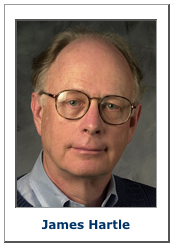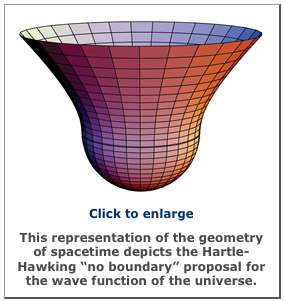 Santa Barbara, CA - James Hartle, research professor at the University of California at Santa Barbara (UCSB), has been named 2009 recipient of the Einstein Prize, awarded biennially by the American Physical Society. The $10,000 prize recognizes "outstanding accomplishments in the field of gravitational physics."
Santa Barbara, CA - James Hartle, research professor at the University of California at Santa Barbara (UCSB), has been named 2009 recipient of the Einstein Prize, awarded biennially by the American Physical Society. The $10,000 prize recognizes "outstanding accomplishments in the field of gravitational physics."
Hartle, who served from 1995 to 1997 as director of the Kavli Institute for Theoretical Physics (KITP), was one of four UC Santa Barbara physicists who banded together to envision such an institute for theoretical physics and to win the National Science Foundation (NSF) competition for the funding that brought that institute to the Santa Barbara campus almost 30 years ago in 1979.
"I am pleased, honored, and surprised," said Hartle of his selection for the Einstein Prize.
Einstein visited Santa Barbara during a trip to California in the 1930s. Fittingly, a photograph of Einstein standing on a vacant Butterfly Beach in Montecito and gazing at the Pacific, hangs in Hartle's physics department office.
Hartle was cited, "For a broad range of fundamental contributions to relativistic stars, quantum fields in curved spacetime, and especially quantum cosmology."
 Einstein's greatest achievement is his theory of general relativity, and Hartle is an expert on the refinements and implications of that theory. The three areas of research singled out in the citation all pertain to general relativity:
Einstein's greatest achievement is his theory of general relativity, and Hartle is an expert on the refinements and implications of that theory. The three areas of research singled out in the citation all pertain to general relativity:
- "Relativistic stars" are so dense that Newton's equations of gravity no longer suffice to describe their structure. A correct description requires the use of Einstein's equations of general relativity. Hartle among others worked out the theory of such relativistic stars.
- Hartle also contributed to development of the formalism (equations) for treating the theory of quantum fields that live in a spacetime that is curved. This effort requires a non-trivial generalization of formalism originally established in flat spacetime.
- Quantum cosmology deals with some of the most difficult conceptual problems in physics, such as the "wave function of the universe," or how to describe the one universe with a theory that is normally interpreted as yielding only probabilities for repeated experiments. In seminal work Hartle, together with long-time collaborator Stephen Hawking, addressed the problem of what might determine the initial conditions that pick out our universe from other possible universes. Their "no boundary" proposal for the wave function of the universe is an elegant speculation as to the origin of the universe and the beginning of time.
After obtaining a 1960 AB from Princeton, Hartle completed a PhD four years later with Murray Gell-Mann at Caltech.
He has held positions at the Institute for Advanced Study in Princeton, as well as the University there, and at the University of Chicago. In addition to his UCSB position, he is currently an external faculty member of the Santa Fe Institute.
He has held Alfred P. Sloan, NATO Senior Science, and John Simon Guggenheim fellowships. A member of the National Academy of Sciences, he is a fellow of the American Physical Society and the American Academy of Arts and Sciences.
